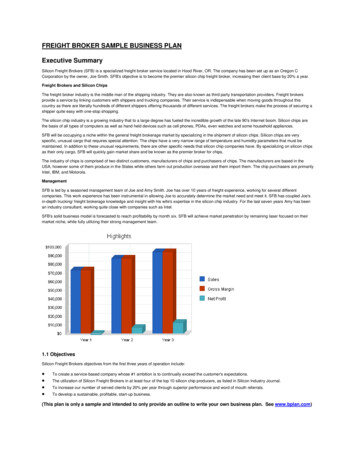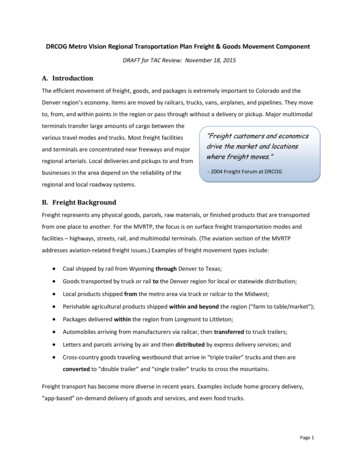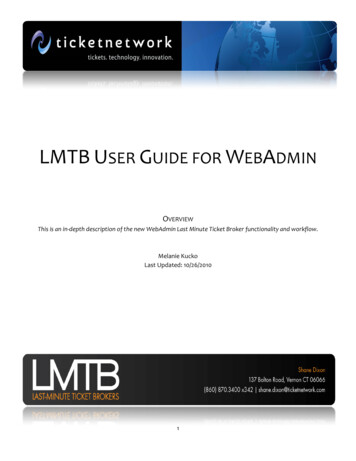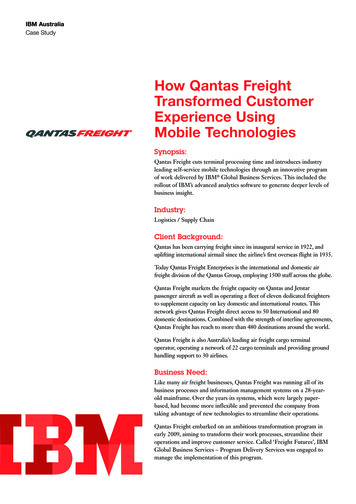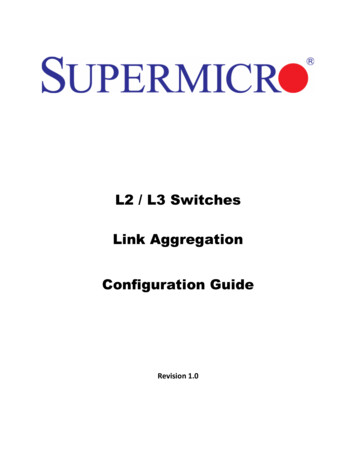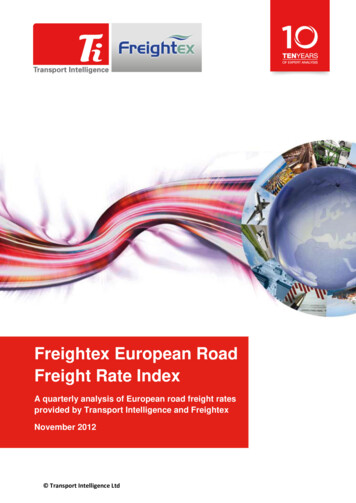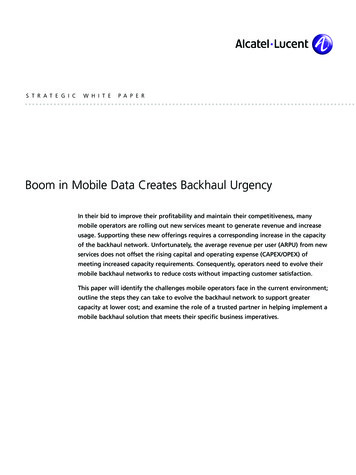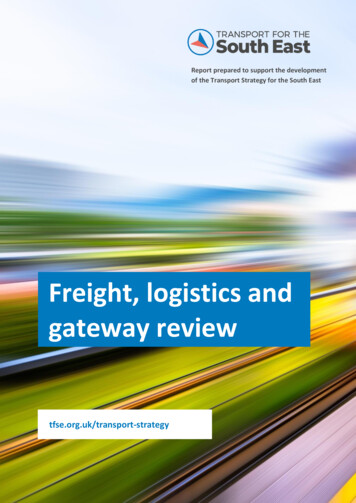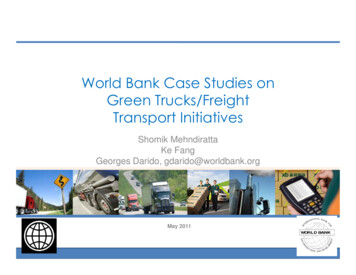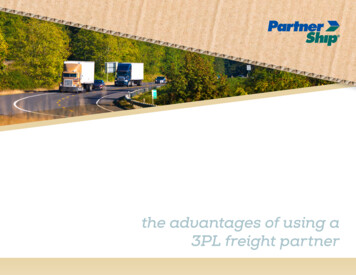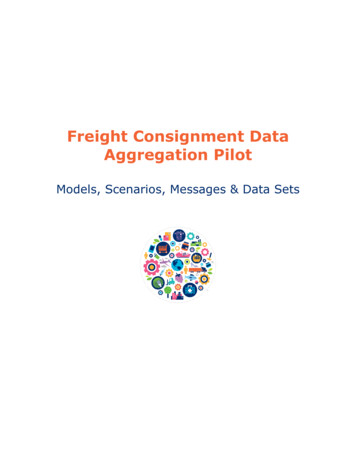
Transcription
Freight Consignment DataAggregation PilotModels, Scenarios, Messages & Data Sets
Version 0.2Prepared by:Earl LappenPrincipal ConsultantGS1 Consulting ServicesGS1 AustraliaRevision /06/202025/06/2020First DraftFinal DraftDistribution ListNameTitleCompanyEarl LappenPrincipal ConsultantGS1 AustraliaBureau of Infrastructure, Transportand Regional EconomicsDepartment of Infrastructure,Transport, Regional Developmentand CommunicationsBureau of Infrastructure, Transportand Regional EconomicsDepartment of Infrastructure,Transport, Regional Developmentand CommunicationsDavid MitchellDirector – Infrastructure andCorridor AnalysisSurya PrakashAssistant Director - Infrastructureand Corridor Analysis BITRE Policyand ResearchEmilie AlexandreSenior Project DevelopmentManageriMOVE AustraliaLee-Ann BregerPrograms DirectoriMOVE AustraliaDisclaimerTHIS DOCUMENT IS PROVIDED “AS IS” WITH NO WARRANTIES WHATSOEVER, INCLUDING ANYWARRANTY OF MERCHANTABILITY, NONINFRINGMENT, FITNESS FOR PARTICULAR PURPOSE, ORANY WARRANTY OTHER WISE ARISING OUT OF THIS SPECIFICATION.GS1 Australia disclaims all liability for any damages arising from use or misuse of this document orits contents, whether special, indirect, consequential, or compensatory damages, and includingliability for infringement of any intellectual property rights, relating to use of information in orreliance upon this document. GS1 Australia retains the right to make changes to this document orits contents at any time, without notice. GS1 Australia makes no warranty for the use of thisdocument and assumes no responsibility for any errors which may appear in the document, nor doesit make a commitment to update the information contained herein.Commercial-in-ConfidenceFreight Consignment Data Aggregation Pilot – Scenarios & Data Set2
Table of ContentsPURPOSE5OVERVIEW AND BACKGROUND5INSIGHTS & APPROACH5INSIGHTSAPPROACHSTANDARDS ADOPTION STRATEGY567GS1 SYSTEM OF STANDARDSGS1 IDENTIFIERSGS1 CAPTURE AND SHAREGS1 GLOBAL DATA STANDARDS (GDS)GS1 ECOM MESSAGING STANDARDSGS1 LOGISTICS INTEROPERABILITY MODEL APPLICATION STANDARDEPC OBJECT & EVENT DATAGS1 GLOBAL TRACEABILITY STANDARD (GTS)GS1 DIGITAL LINK & RESOLVERGS1 REGISTRIESGS1 GLOBAL DATA SYNCHRONISATION NETWORKDATA INTEGRATION INTEROPERABILITY MODELPARTIES RELATED TO THE SCENARIOS77888999910101216PROCESS FLOWS FOR PROJECT 117SCENARIO 1SCENARIO 2PROCESS FLOWS FOR PROJECT 2171819SCENARIO 3SCENARIO 4SCENARIO 5TRANSPORT EXECUTION MESSAGES19212224EDI TRANSPORT MESSAGE TYPESEPCIS MESSAGE TYPESPROCESS FLOW SCENARIO EVENTS, STEPS & STATUS UPDATES262627VISIBILITY & TRACKING INFORMATION28CARRIER VISIBILITY & TRACKING INFORMATIONSENDER VISIBILITY & TRACKING INFORMATIONDATA AGGREGATION282930DATA EXCHANGE MODELRECOMMENDATIONS FOR MOVING BEYOND THE PILOT3031EXPANDING COLLABORATIONESTABLISHING PRODUCTS, TOOLS AND TECHNIQUESPLANS FOR THE eight Consignment Data Aggregation Pilot – Scenarios & Data Set3
PROCESSES, EVENTS, PARTIES AND ROLESFREIGHT DATA SETS AND ATTRIBUTESTRANSPORT INSTRUCTION MESSAGE STRUCTURE AND CONTENTTRANSPORT STATUS NOTIFICATION INSTRUCTION MESSAGE STRUCTURE AND CONTENTEPCIS TRANSACTION EVENT MESSAGEEPCIS OBJECT EVENT MESSAGEGS1 GLOBAL DATA DICTIONARY (GDD) CODE LISTS AND CODES USED FOR THE PILOTFREIGHT DATA EXCHANGE PROTOTYPE DATABASE TABLES AND DATA Commercial-in-ConfidenceFreight Consignment Data Aggregation Pilot – Scenarios & Data Set4
PurposeThis document outlines the background, approach, standards adoption strategy, processflow scenarios, freight transport messages and data sets, interoperability and dataexchange models, and data aggregation, applied to deliver the outputs of the FreightConsignment Data Aggregation pilot project.Overview and BackgroundEnd to end supply chain visibility has grown to be a key focus area for many supply chainparticipants, however the reality of today’s supply chains is that this is largely nonexistent. The constraints of manual, paper based processes and bespoke, proprietarysystems that are difficult to integrate makes it virtually impossible.The goal of freight data exchange is to encourage all supply chain trading partners toengage in the act of exchanging freight data between themselves and by doing so achievea connected freight information exchange network and a National Freight Data Hub.Logistics systems require large amounts of data, including information about locations,geography, service providers, rates, itineraries, as well as transactional data such as ordersand shipment status and much of this data comes from traditional ERP and TransportManagement Systems.The pilot project looks at two main aspects of data: data discoverability, and standardscompliance and interoperability. For data discoverability, there is an exploration of some of the public-facing aspectsof datasets and attributes, and data aggregation. For standards compliance and interoperability, there is an exploration of thevarying use of standards as they relate to the context of defined freightmovements.This exploration is necessarily contextualised within the larger data ecosystem of a nationalfreight data infrastructure.This document highlights Global Data Standardisation, EDI and EPCIS standard messagesand related schemas, and Data Sets and attributes, applied across various multimodalfreight movement scenarios.Insights & ApproachInsightsEstablishing standardised information flows across the freight supply chain, enabledthrough a collaborative standardisation effort between trading partners, will supportcurrent and future needs of freight logistics.Additionally, the importance of establishing a goal for: data standards compliance and interoperability, a technique for searching multiple databases simultaneously, and a means for data aggregation to assist decision making,Commercial-in-ConfidenceFreight Consignment Data Aggregation Pilot – Scenarios & Data Set5
is a well-recognised objective.As this initiative potentially scales in the future, standards compliance and interoperabilitywill also need to address aspects of: DATA CAPTURE – Data/Records/Transactions capture DATA COLLECTION – Data gathering and maintaining updated Data Repositories DATA SHARING – Making data available by enabling Querying/API Pull/Send file ormessageAim Generating transport messages that would provide visibility and information relatedto multimodal freight consignment movements between supply chain partners. Collection of these transport message and provision of a data set to harness freightdata aggregation and analytics within a BITRE database. Use of GS1 Transport Instruction and Transport Status EDI messaging and GS1EPCIS Event Data messagesApproachGenerating a large volume of synthetic transport messages (EDI and EPCIS) to substitutefor freight consignment movement transactions based on 5 scenarios depicting the UseCases for: Pilot project 1: Supply Chain Freight Data Trial (Nestle, Toll Group, Woolworths) –Intrastate by Road (scenarios 1 & 2) Pilot project 1: Supply Chain Freight Data Trial (Nestle, SCT Freighters,Woolworths) – Intrastate movement from NSW to WA by Road and Rail (scenario4) Pilot project 2: Multimodal Supply Chain Trial (Infrabuild, K&S Freighters, PacificNational Rail) – Interstate movement from NSW to Far North Queensland by Roadand Rail (scenario 3) Pilot project 2: Multimodal Supply Chain Trial (Infrabuild, K&S Freighters, SWIREShipping) – Interstate movement from VIC to TAS by Road and Sea (scenario 5)Design & Build of the prototype data aggregation database to test system components anddevelop prototype reports.Uploading messages to the data aggregation database for reporting outputs.OutcomeEnabling the use of real messages (when available) to be used in a “plug and play” fashiontogether with the developed data aggregation database and reporting capability.Freight consignment data collected as a by-product of electronic data exchanged betweensupply chain partners, if collected in sufficient scale, can potentially provide an alternativemeans of collecting freight data, more regularly and more frequently, and better helpinform freight-related network planning, infrastructure investment and freight policy.Commercial-in-ConfidenceFreight Consignment Data Aggregation Pilot – Scenarios & Data Set6
Standards Adoption StrategyGS1 System of standardsThe GS1 System of global standards provides a framework that allows products, services,and information about them to move efficiently and securely through supply chains.The GS1 system comprises a comprehensive set of standards to identify, capture and shareinformation about objects throughout their lifecycle, providing the core foundation forinteroperability:1. Supply chain partners identify business objects and locations using standardisedidentifiers.2. Supply chain partners capture an object’s identity and any additional attributesthat have been encoded in a standard manner in a data carrier (barcodes, RFID).This ensures the object can be read automatically, and location (where) and otherdata (who and why) is recorded.3. Once supply chain partners are using a common language for identification anddata capture, the gathered data is refined and enhanced with business context, totransform it into data that can be shared using standardised semantics, in astandardised format, and using standard exchange protocols.Using GS1 Standards, diverse business processes interact and interoperate seamlesslyacross different trading partners’ organisational boundaries, leading to operationalefficiencies.These standards offer a comprehensive, out of the box toolkit of enabling data structures,dictionaries, definitions, and vocabularies that work to streamline system to systemintegration, independent of any specific technology platform. In essence, “the GlobalLanguage of Business”.GS1 IdentifiersGS1 identifiers provide all trading partners with a standard way to uniquely identify each“physical component” or “object” in the supply chain, these include: Logistics units, which can be any combination of goods put together in a carton,in a case, or on a pallet – the Serial Shipping Container Code or SSCC. Logical groupings of logistics units that are assembled to be transported such asa consignment – the Global Identification Number for Consignment or GINC -- oras a shipment – the Global Shipment Identification Number or GSIN.The difference is that the GSIN is used to identify a shipment that has to be movedfrom one place to another, irrespective of the physical handling, while the GINC isused by LSP’s to identify groupings of logistics units as appropriate in the chosenway of transport. Hence, one GSIN can result in several consignments, while in oneconsignment, goods from several shipments can be shipped. The GSIN is incompliance with Customs requirements for the Uniform Consignment Reference orUCR. Individual assets used to transport the goods – assets like a ship containerand truck/trailer –the Global Individual Asset Identifier or GIAI - as well asreturnable assets like a returnable pallet used for packaging – the GlobalReturnable Asset Identifier or GRAI.Commercial-in-ConfidenceFreight Consignment Data Aggregation Pilot – Scenarios & Data Set7
Physical locations or trading partners like retailers, manufacturers, transportcarriers, freight forwarders and LSPs – the Global Location Number or GLN. Trade items like products and services that may be priced, or ordered, or invoicedat any point in any supply chain – the Global Trade Item Number or GTIN.GS1 Capture and ShareThe GS1 identifier for logistics units or SSCC (and all the information it holds) is capturedon a case or pallet using a GS1 Logistics Label, which is the Standard InternationalLogistics Label (STILL). This label is the GS1 recommendation on what data – in bothhuman readable and barcoded formats – should be used when labelling logistics units inthe transport and warehouse management processes.Using the GS1 Logistics Label, the SSCC “stays on” the logistic unit through the wholesupply chain, giving all trading partners a common reference back to the origin of thelogistic unit and who is responsible for the goods. This is especially helpful as retailersreceive goods, possibly from freight forwarding processes; and it enables these retailers toconfirm receipt of the accurate shipment of goods. GTINs are encoded in barcodes thatcapture all information about those trade items.Trading partners can share real-time information about the physical events in the supplychain using GS1 eCom messaging standards and Electronic Product Code InformationServices (EPCIS), and use the Global Data Synchronisation Network (GDSN) as means forsecure and continuous synchronisation of accurate product master data sharing.As a basis for its strategy, the freight data exchange pilot project has embracedthe following GS1 standards:GS1 Global Data Standards (GDS)GS1 Global Data Standards (GDS) relate to standardisation and automation of identificationand messaging between participants through creating the ability to identify, capture andshare data. Efficiency gains are typically realised by using unambiguous globally uniqueidentification codes along with the electronic data capture and data exchange of dataacross the value chain thus effectively “connecting” a myriad of disparate systems. Theuses of Global Data Standards (GDS) are relevant to most phases of the supply chain,starting from the exporters, third party logistics providers, customs and/or borderagencies, importers, wholesalers and distributor, retailers/customers, and consumers.GS1 eCom Messaging StandardsElectronic Data Interchange is the transfer of data from one computer system to anotherby standardised message formatting, without the need for human intervention. EDI permitsmultiple firms - possibly in different economies – to exchange documents electronically.GS1 eCom messaging standards define the business messages that are exchangedbetween trading partners. Whether planning or executing, trading partners can collaboratewithout having to reinvent processes and messaging for each new partner, order, orshipment. These electronic messages reduce manual entry efforts and paperwork andstreamlines communications.Commercial-in-ConfidenceFreight Consignment Data Aggregation Pilot – Scenarios & Data Set8
GS1 Logistics Interoperability Model Application StandardCreated by the GS1 Logistics Transport & Logistics community, this standard is based onthe Logistics Interoperability Model (LIM). The foundation for the solution is a framework ofcommon business scenarios and processes supported by the exchange of relatedinformation from master data alignment, procurement, planning, warehousing, transport,to financial settlement.Its aim is to establish interoperability in these business processes so that they runseamlessly across trading partner organisational boundaries.EPC Object & Event DataElectronic Product Code Information Services (EPCIS) is a standard developed by GS1to capture and report event-based traceability data. EPCIS helps to capture visibility eventdata along the supply chain. Visibility event data details physical or digital activity in thesupply chain of products and other assets, identified by keys, detailing where the objectsare in time, and why, not just within an organisation, but across organisations.EPCIS enables disparate applications to create and share event based traceability data,both within and across enterprises, on the physical movement of goods or objects, thelocation of goods or other assets (transport equipment, returnable assets like pallets),making it possible to understand what actually happened as goods and assets are handledby trading partners in manufacturing sites, warehouses, retail stores and other facilities.EPCIS enables EPC Object and Event visibility data to be captured, shared, and queried.GS1 Global Traceability Standard (GTS)Global Traceability Standard (GTS) enables the creation of interoperable traceabilitysystems. The objective of this standard is to assist organisations and industries in thedesign and implementation of traceability systems based on the GS1 system of standards.At a strategic level, this standard aims to provide key insights and knowledge toorganisations or industries that are developing long-term traceability goals.GS1 Digital Link & ResolverGS1 Digital Link enables connections to all types of business-to-business and business-toconsumer information. With GS1 Digital Link, any set of GS1 Identifiers can exist as a Webaddress. GS1 Digital Link provides the opportunity to use GS1 Identifiers to access digitalinformation and to easily resolve to resources on the Web. GS1 Digital Link has twocapabilities:1. The capability to easily resolve to resources (e.g. information) on the Web (thiscapability is usually associated with URLs and Web addresses).2. The capability to provide a globally unambiguous name for anything, whether thething exists only on the Web or in the real world (this capability is usuallyassociated with URNs).Commercial-in-ConfidenceFreight Consignment Data Aggregation Pilot – Scenarios & Data Set9
GS1 RegistriesGlobal Location Numbers (GLNs) are now very widely used globally in many sectors foridentification of locations and parties within the supply chain. In many countries GLNs areused by suppliers, retailers, government health authorities, hospital networks and farmsamong others for identification of individual locations and legal entities. Likewise,distributors, wholesalers, pharmacy chains and suppliers commonly use GLNs to identifywarehouses, sites, office locations, store locations, warehouse bays, and so on.Once GLNs are assigned, trading partners need to exchange information about the party orlocation to which the GLN has been allocated. Information that needs to be exchanged mayinclude: The name of the location Location function Location address Contact details for location Parent and child locations related to this GLNToday, this information is commonly exchanged via email, letter, spread sheet, oralternatively stored on trading partner Web sites. Each of these methods of GLNinformation exchange is point-to-point or peer-to-peer, meaning that additional time andeffort is taken by the GLN allocator to ensure information exchange with all tradingpartners.GS1 Locate is a GLN registry that provides a centralised location for storage of GLNinformation as well as a mechanism for suppliers and buyers to have a one-to-manycommunication of their GLN data and associated information with a single point of useraccess.GS1 Global Data Synchronisation NetworkThe Global Data Synchronisation Network or GDSN provides an environment for secure andcontinuous synchronisation of accurate product master data exchanges between supplychain trading partners.By using the GDSN, trading partners always have the same information in their systems,and any changes made to one company’s database are automatically sent to all the othertrading partners. The Australian GDSN solution is called the National Product Catalogue(NPC) and is endorsed and utilised by all of Australia's state, territory and federal healthdepartments, private health providers, pharmacy wholesalers, retailers and is also used bytrading partners and service providers across a variety of different industry sectors.Commercial-in-ConfidenceFreight Consignment Data Aggregation Pilot – Scenarios & Data Set10
The following diagram depicts the GS1 system of standards suite embraced by thefreight data exchange pilot project.GS1 Global Data Standards (GDS)GS1 SystemIdentify, Capture, ShareGS1 eComMessaging StandardsOrder to CashGS1 LogisticsInteroperability Model(LIM)EPC Object & Event Data, GTSGlobal Traceability Standard(GTS)GS1 Digital Link & ResolverGS1 Digital LinkGS1 RegistriesGS1 LocateCommercial-in-ConfidenceFreight Consignment Data Aggregation Pilot – Scenarios & Data Set11
Data Integration Interoperability ModelThe goal of freight data exchange is to encourage all trading partners to engage in the act of exchanging freight databetween themselves and by doing so achieve a connected freight information exchange network and a NationalFreight Data Hub.This Data Integration Interoperability Model will provide for consistent data models, documentation, improvedsecurity and near real-time integration, and the establishment of Data Level Agreements to streamline the process ofgranting trading partner application access to the required freight data.Aim: To have an API (Application Programming Interfaces) based Data Integration Interoperability Model thatprovides for interoperability with external applications and systems to achieve a consistent approach to data sharing,that ensures: Freight data can be exchanged between external applications and systemsSimplified authorised access to multiple data sourcesProper security authentication when receiving and/or sending dataMinimal data movementSelf-service access to dataSecure techniques for data exchangeAccess to data via Applications, Systems and IoT devicesEnsure Personal Identifiable Information (PII) and Protected Data is stripped from the source dataTrading partners can leverage API integration to reap the benefits of using APIs alongside other methods ofdata exchange between separate systemsThis model requires: A Data Level Agreement to streamline the process of granting trading partner application access to therequired dataInternal Applications and Systems support for generic API integration and Web service connectionsAPI access to data provided by RESTful architecture based on proven standards, protocols, and designsData Exchange typically follows the following pattern: Each trading partners captures freight data into their internal applications and systemsEach trading partner allows secure access to their internal applications and systems dataThe data is retrieved over an interface to the receiving applicationThe receiving application parses the data and imports it into their internal applications and systems or a dataaggregator application for analytics and reporting
Commercial-in-ConfidenceFreight Consignment Data Aggregation Pilot – Scenarios & Data Set13
A few basic notations to help understand the Data Integration Interoperability Model diagram above,are listed below:Data ExchangeBAU DataFlowsDescriptionBusiness As Usual DataFlowsDefinitionData flows from, to and between Buyer, Logistics Partner and Seller. Theseinclude E-mail, eCommerce Messages.Material FlowsPhysical freight flowsPhysical movement of freight between Seller, Logistics Partner and Buyer.API Pull/PushAPI Pulls and PushesAn API based data sharing approach to interoperability enables: Simplified access to multiple data sourcesMinimal data movementSelf-service data access to dataSecure techniques for data exchangeRequires Application and System support for generic API integrationand Web service connections, i.e. to provide web-based API.DLR RequestsDigital Link & Resolver(DLR) FlowsGS1 Digital Link enables connections to all types of business-to-businessand business-to-consumer information. With GS1 Digital Link, any set ofGS1 Identifiers can exist as a Web address.GS1 Digital Link provides the opportunity to use GS1 Identifiers to accessdigital information and to easily resolve to resources on the Web. GS1Digital Link has two capabilities:1. The capability to easily resolve to resources (e.g. information) onthe Web (this capability is usually associated with URLs and Webaddresses).2. The capability to provide a globally unambiguous name for anything,whether the thing exists only on the Web or in the real world (thiscapability is usually associated with URNs).The role of the Resolver is to resolve the Identifier(s) and to forward therequest to the correct destination where more information can be found.The resolver provides the relevant API call to get to an event/datarepository.ETL FlowsExtract Transfer LoadFlows pushes data to theBITRE Data Aggregator(Freight Data Hub)ETL Flows enable bulk direct transfer of data, where the required data isextracted periodically from internal applications into one or more fileswhich are then transferred via FTP/ASN to BITRE for subsequent loading tothe Freight Data Hub.Commercial-in-ConfidenceFreight Consignment Data Aggregation Pilot – Scenarios & Data Set14
EPCISEPC Object & Event Data, GTSGS1 GlobalDataStandards(GDS)GS1 Global DataStandards (GDS)EPCIS enables disparate applications to create and share event basedtraceability data, both within and across enterprises on the physicalmovement of goods or objects. EPCIS enables visibility data to be capturedand queried, and the Global Traceability Standard (GTS) enables thecreation of interoperable traceability systems.GS1 Global Data Standards (GDS) relate to standardisation and automationof identification and messaging between participants through creating theability to identify, capture and share data.About APIsAn API (Application Programming Interfaces) is a set of standards that enable communication between multiplesources such as business applications, mobile applications, devices, etc. APIs provide a standardised, public interfaceso any authorised application can receive and/or send data with the proper security authentication.APIs for data integration and data sharingAPIs offer a cheaper, lighter, and easier format of interoperability powered by RESTful web services. Providers cancreate a robust APIs and gain the flexibility to facilitate external data-sharing requests by simply sharing anapproved API standard. Access to data via APIs allows the aggregation of data for use by external applications.How APIs workApplication specific APIs allow other technologies to look inside their databases. These APIs control the amount ofopenness it provides other applications. Some only allow the ability to read data with the API. Others allow the abilityto read, write, and delete to the database using a specified set of standards.APIs allow interaction with the data within the secured database that adhere to the approved API standardspecifications. Modern, web API technology gives electronic devices and applications simple, fast access into otherapplications’ data. Web APIs are methods of secure communication between electronic devices over the internet thatmake it easier to communicate data between applications, regardless of the operating system or software in use.Web services has readily defined security protocols (HTTPS) along with commonly used authentication techniques.Being able to leverage widely used security standards makes implementation much easier and will provide looselycoupled interoperability for a variety of data users. All these benefits are provided by the RESTful architecture basedon proven standards, protocols, and design patterns.Commercial-in-ConfidenceFreight Consignment Data Aggregation Pilot – Scenarios & Data Set15
Parties related to the ScenariosThe parties related to the process flow scenarios defined in this document include: Sender – Supplier/Manufacturer (Origin/Source of product, material, or goods),Receiver – Customer/Retailer (Buyer of product, material, or goods),Consignor – Logistics/Transport Service Client (Provides the cargo), andConsignee – Logistics/Transport Service Provider (Carrier - Collects, Transports and Delivers the cargo).Commercial-in-ConfidenceFreight Consignment Data Aggregation Pilot – Scenarios & Data Set16
Process Flows for Project 1The process flow scenarios depicted below corresponds to the Use Cases considered for Project 1.Scenario 1 Freight movement by RoadIntrastate movement within NSWo Direct delivery from Origin to Destination Arndell Park to Bella Vista Nestle Arndell Park DC (12/15 Contaplas St, Arndell Park NSW 2148) To Woolworths Bella Vista DC (1 Woolworths Way, Bella Vista NSW 2153)ROADSend Contract TransportEvents:Ship / DeliverCollect Loaded Departed ReceiveTransport In-Transit DeliverArrived Unloaded DeliveredEvent oadingStagingDeliveredCommercial-in-Confidence1st Leg - ROAD15min – 60min10min – 30minArndell Park to Bella Vista(13.8 km)25 min – 60min10min – 30min15min – 60min10min – 30min2nd Leg-3rd Leg---Freight Consignment Data Aggregation Pilot – Scenarios & Data Set17 Receive Received
Scenario 2 Freight movement by RoadIntrastate movement within NSWo Indirect delivery from Origin to Transport Provider DC and on to Destination Arndell Park to Bella Vista via Transport Provider Eastern Creek DC Nestle Arndell Park DC (12/15 Contaplas St, Arndell Park NSW 2148) To Toll Eastern Creek DC (7 William Dean St, Eastern Creek NSW 2766) To Woolworths Bella Vista DC (1 Woolworths Way, Bella Vista NSW 2153)ROADSend Contract TransportShip / DeliverCollect ReceiveTransport In-Transit Deliver ReceiveEvents: Loaded Departed Arrived Unloaded Delivered Received1st Leg2nd Leg Loaded Departed In-Transit Arrived Unloaded Loaded Departed In-Transit Arrived Unloaded Delivered ReceivedEvent oadingStagingDeliveredCommercial-in-Confidence1st Leg - ROAD15min – 60min10min – 30minArndell Park to Eastern Creek(2.7 km)10 min – 20min10min – 30min15min – 60min15min – 60min2nd Leg - ROAD15min – 60min10min – 30minEastern Creek to Bella Vista(18.9 km)25 min – 60min10min – 30min15min – 60min10min – 30minFreight Consignment Data Aggregation Pilot – Scenarios & Data Set3rd Leg-18
Process Flows for Project 2The process flow scenarios depicted below corresponds to the Use Cases considered for Project 2.Scenario 3 Freight movement by Road and Railo Interstate movement from NSW to Far North Queenslando Indirect delivery from Origin to Tr
Uploading messages to the data aggregation database for reporting outputs. Outcome Enabling the use of real messages (when available) to be used in a "plug and play" fashion together with the developed data aggregation database and reporting capability. Freight consignment data collected as a by-product of electronic data exchanged between
